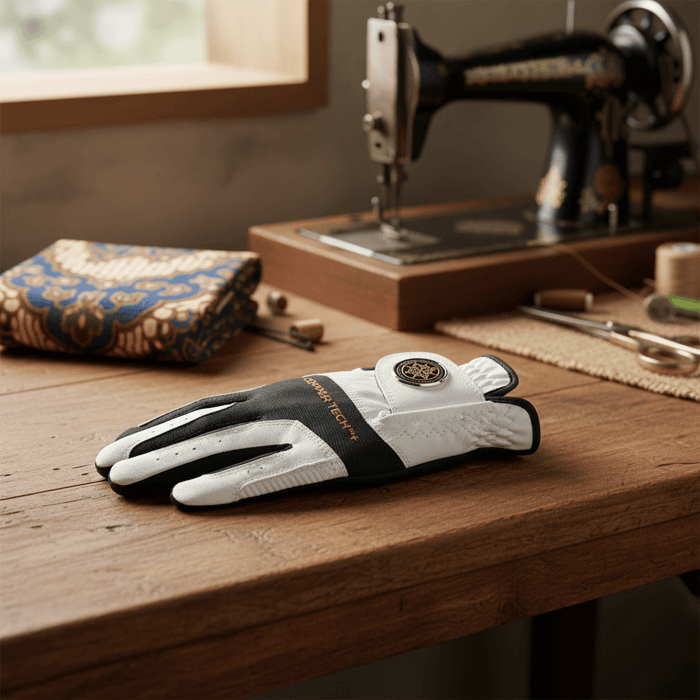Table of Contents
Your $30 leather glove might actually be the worst thing in your bag. I know, that sounds controversial, but hear me out. That classic, soft leather appeal feels fantastic for your first round, but it quickly degrades, turning into a source of slippage, frustration, and lost confidence far sooner than you’d think.
Here's the honest truth: when the material breaks down, your grip suffers. A compromised grip means you’ll have to squeeze the club harder, which creates tension, slows your clubhead speed, and leads to inconsistent contact.
If you’ve been wearing the same glove for months, treating it more like a lucky charm than a piece of performance equipment, you're certainly not alone. But it’s time for an equipment check.
As someone who tracks their gear's performance closely, I’m going to show you the 5 critical signs that your glove is past its prime. Recognizing these indicators will stop the silent sabotage and transform your grip, giving you the control you need to start shaving strokes off your score.
The Problem: Why Bad Gear Ruins Your Swing
Think of your glove as the only true physical link between you and the club. If that link is weak, your whole body tries to overcompensate.
This is the silent killer of consistency: poor grip.
Instead of trusting a tacky glove to hold the club, a worn-out one forces you to over-grip. That tension rockets up your forearms and wrists, tightening your shoulders and completely restricting your natural swing. What happens then?
You lose clubhead speed (slower drives).
You can’t properly release the club (hello, push or slice).
You lose all feel on short chips and putts.
You really shouldn't have to white-knuckle the club to keep it stable. A quality glove lets you use a light, controlled grip—and that’s the real foundation of a great golf swing.
How Long Should Your Glove Really Last?
The lifespan of a glove changes a lot based on your local climate and how often you play, but you should have a baseline expectation:
Glove Material | Expected Life Span (Frequent Play) | How It Breaks Down |
Traditional Leather | 8 to 15 rounds | Sweat, moisture, and drying out stiff. |
Traditional Synthetic | 15 to 30 rounds | Loss of initial grip, stretching, and peeling. |
The takeaway here is simple: gloves are a consumable item, just like balls or tees. Holding onto one too long is like playing with worn-out grooves—you’re basically giving yourself a penalty before you even tee off.
The 5 Critical Signs It’s Time to Replace Your Golf Glove
You don’t have to wait for a massive hole to appear. Pay attention to these clear, actionable performance cues.
Sign 1: Loss of Tackiness (Try the ‘Slipping Club’ Test)
This is the most important sign, and it’s the one golfers miss most often. That initial "tacky" grip your glove provides is what lets you hold the club lightly but securely.
The Test: Focus during a full swing, especially your driver. A glove has lost its tackiness when the club feels like it twists or slips slightly in your hand right at impact, forcing a small, tight re-grip as you finish your swing. Even that tiny movement is enough to mess up your consistency.
If your glove feels slick, particularly under the thumb pad or across the palm, it’s done.
Sign 2: The ‘Crunchy’ Texture and Stretched-Out Fit
Your glove should feel like a second skin. If you pull off your glove and it’s gone from soft and smooth to stiff, crunchy, or brittle, it’s time to replace it.
This change is what happens when sweat, dirt, and oil soak into the material and permanently change its structure. A crunchy glove can’t flex naturally, which restricts your movement and feels awful.
Also, look closely at the fit. If the glove no longer wraps snugly around your hand and you see wrinkles or excess material bunching in the palm when you grip, it's stretched out. A loose fit means you’ll lose control.
Sign 3: Physical Wear and Tear (Holes, Tears, and Fraying)
This is the most obvious indicator, but I see golfers trying to nurse a glove back to life until it’s practically in shreds.
Replace your glove immediately if you see holes, especially in the palm or the thumb pad. Holes often appear where your grip is positioned incorrectly, and once they start, they compromise the glove's whole structure. Fraying seams are also failure points that quickly turn into big tears.
Sign 4: Extreme Discoloration and Permanent Stains
A little dirt is fine—it’s golf. But dark, permanent stains or heavy discoloration, especially from sweat along the fingers and palm, are visual proof that the glove’s fibers are saturated and compromised.
These stains aren't just ugly; they show the material has absorbed so much moisture and oil that its original density and performance are gone. This saturation is what usually leads to that "crunchy" feel we talked about.
Sign 5: The Smell Test (Beyond Just 'Stale')
I get it, your golf bag isn’t a scent display, but if a glove has a persistent, strong, foul odor that sticks around after it's had a full day to air dry, it means there's a serious buildup of oils and bacteria.
That nasty buildup is actively degrading the material’s elasticity and tackiness from the inside out. When you hit that stage, the glove's lifespan is over and you need a fresh start.
The Solution: Upgrade Your Durability with Copper Tech
If you’re tired of replacing stiff, crunchy, or slick gloves every few weeks, you need to break the cycle. The Problem (slipping) and the Journey (buying yet another traditional glove) stop here.
The Solution is to use modern material science to create a superior, long-lasting grip.
We engineered the Copper Tech Golf Glove specifically to solve the biggest failures of traditional gloves—rapid degradation from sweat and loss of tackiness.
The glove’s advanced material technology gives you a real performance edge:
Exceptional All-Weather Grip: The synthetic construction holds its tackiness and grip perfectly in dry conditions and high humidity, eliminating that mid-round slide from sweaty hands.
Rapid Moisture Wicking: It actively manages sweat, preventing the material from getting saturated, which is what causes that permanent "crunchy" feel in traditional gloves.
Superior Durability: The engineered material resists stretching and stiffness, so it keeps a like-new fit much longer than leather gloves will.
This isn’t just buying a replacement glove; it’s a transformation. It lets you stop worrying about your equipment and simply have an effortless grip, confident swings, and sustained peak performance round after round.
Expert Maintenance: Get More Life Out of Your Next Glove
Even the most technologically advanced glove benefits from a little TLC. Use these simple tips to get the maximum lifespan out of your next glove:
Quick Tips for Proper Storage and Cleaning
Always Air Dry Flat: Never just wad your glove up and toss it in your bag or a shoe. Lay it flat immediately after the round and let it air dry naturally in a cool, ventilated place. Keep it out of direct sun or a hot car.
Rotate Your Gloves: If you play frequently, use two gloves and alternate between them. This allows each one to completely dry and recover its shape between rounds.
Clean Gently: To remove simple surface dirt, lightly wipe the glove with a cloth dampened with water only. Don't use harsh soaps, detergents, or a washing machine; those chemicals strip the essential properties right out of the material.
Your glove is the easiest, most affordable upgrade you can make to your game. Stop costing yourself strokes with worn-out gear.
See why thousands of golfers trust the durability and technology of the Copper Tech Golf Glove and experience the transformation of a confident, effortless grip.


.jpg)


